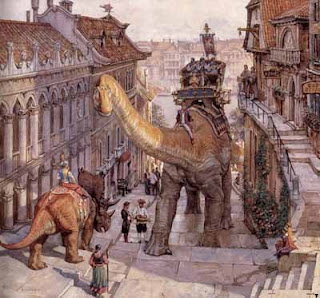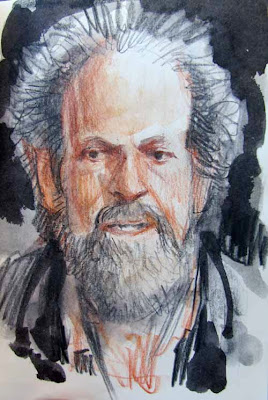But I always wondered: Did he scrape off each false start and then begin all over again? Or did he just work over the previous start after it had dried? How did he know when a painting was going wrong?
Thanks to two of his former pupils, Miss Heyneman and Mr. Henry Haley, we have an idea of his methods:

"He drew a full, large brush down the whole contour of a cheek (over one of her half-finished studies), obliterating apparently all the modeling underneath, but it was always further to simplify that he took these really dreadful risks, smiling at my ill concealed perturbation and quite sympathizing with it.
"The second painting taught me that the whole values of a portrait depends upon its first painting, and that no tinkering can ever rectify an initial failure. Provided every stage is correct, a painter of Mr. Sargent's caliber could paint for a week on one head and never retrace his steps -- but he never attempted to correct one. He held that it was as impossible for a painter to try to repaint a head where the understructure was wrong, as for a sculptor to remodel the features of a head that has not been understood in the mass. That is why Mr. Sargent often repainted the head a dozen times, he told me that he had done no less than sixteen of Mrs. Hammersley.
“When he was dissatisfied he never hesitated to destroy what he had done. He spent three weeks, for instance, painting Lady D' Abernon in a white dress. One morning, after a few minutes of what was to be the final setting, he suddenly set to work to scrape out what he had painted. The present portrait in a black dress (above), was done in three sittings.
“He did the same with the portrait of Mrs. Wedgwood, and many others. Miss Eliza Wedgwood relates that in 1896 he consented, at the insistence of Alfred Parsons, to paint her mother. She sat for him twelve times, but after the twelfth sitting he said she would both be the better for a rest.
“He then wrote to Miss Wedgwood that he was humiliated by his failure to catch the variable and fleeting charm of her mother's personality -- that looked like the end of the portrait. Some weeks later he saw Mrs. Wedgwood at Broadway, and struck with a new aspect he said:
‘If you will come up next week we will finish that portrait.’
“She came to Tite Street, a new canvas was produced, and in six sittings he completed the picture which was shown at the Memorial Exhibition.
“I have also seen the assertion that he painted a head always in one sitting. He painted a head always in one process, but that could be carried over several sittings. He never attempted to repaint one eye or to raise or lower it, for he held that the construction of a head prepared the place for the eye, and if it was wrongly placed, the understructure was wrong, and he ruthlessly scraped and repainted the head from the beginning. That is one reason why his brushwork looks so fluent and easy; he took more trouble to keep the unworried look of a fresh sketch than many a painter puts upon his whole canvas.
“The purpose of all this reworking was to: develop (in Sargent's words) ‘an appetite to attack the problem afresh at every sitting, each attempt resulting in a more complete visualization in the mind. The process is repeated until the canvas is completed.’”
Thanks, Walt Morton!














































